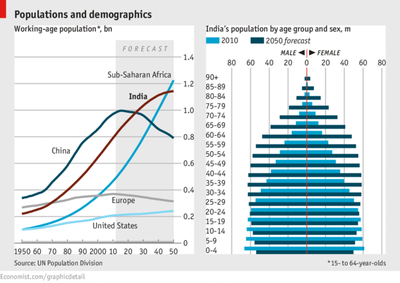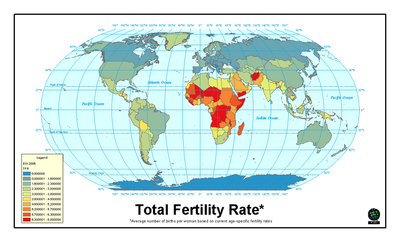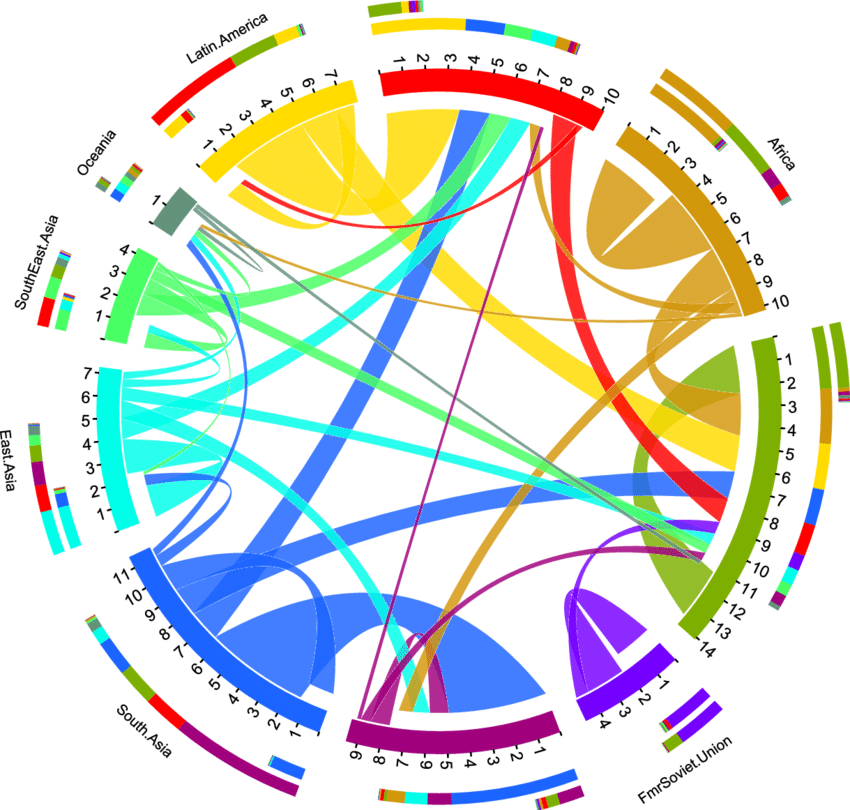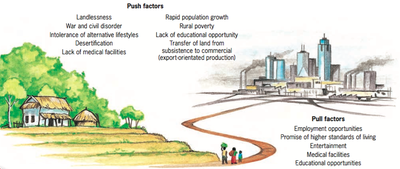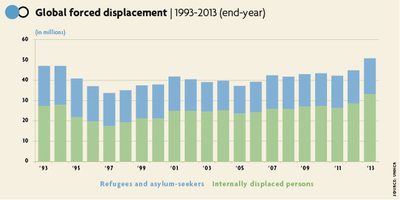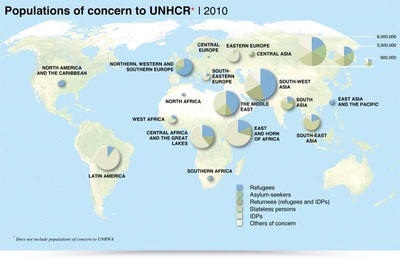The global population
|
|
|
Variation in spatial patterns of population
While the world's population is growing rapidly, this is not true in all countries. This produces what are know as a spatial patterns in population statistics. The population in some countries (mostly MEDCs) is very stable or in fact declining. While in Less Economically Developed Countries (LEDCs) fertility rates are higher, but falling as standards of development and human wellbeing improve. Whatever the case, all populations are a product of fertility rates, death rates (referred to as natural increase or decrease) and migration.
The large population growth being witnessed globally is largely taking place in the LEDCs of Asia and Africa. These countries have higher fertility rates and rapidly declining death rates.
In most MEDCs, populations are either stable and ageing or actually declining. These countries have very low birth rates and death rates. Ageing is a considerable economic problem for the world's World Cities
These forces will likely cause the global population to level out at around 9 billion people by the middle of the 21st Century. It is possible, however, that death rates increase in the future, either due to higher rates of pollution and obesity, new pandemics such as Covid-19, the failure of antibiotic resistance, large scale wars or some other unknown risk.
The large population growth being witnessed globally is largely taking place in the LEDCs of Asia and Africa. These countries have higher fertility rates and rapidly declining death rates.
In most MEDCs, populations are either stable and ageing or actually declining. These countries have very low birth rates and death rates. Ageing is a considerable economic problem for the world's World Cities
These forces will likely cause the global population to level out at around 9 billion people by the middle of the 21st Century. It is possible, however, that death rates increase in the future, either due to higher rates of pollution and obesity, new pandemics such as Covid-19, the failure of antibiotic resistance, large scale wars or some other unknown risk.
|
Our World in Data - Fertility rates
Fertility rates often reflect a combination of child survival and cultural beliefs about appropriate family size. |
Our World in Data - Life expectancy
Life expectancies have steadily increased in all countries and is now globally above 70 Years of age. |
Using population graphsGeographers use both the data and the shape of population graphs to gleen information about a society. They are an essential skill.
It is important to be able to draw data from the various male and female cohorts. However, it can be almost as valuable to be be able to recognise the shapes produced by high death rates, high or low fertility rates and population booms |
|
The Demographic Transition Model
Populations have usually followed a classic demographic transition model as they have improved their level of development and human wellbeing. In all societies, death rates decline first, fertility rates follow and as these two factors change total populations stop increasing and level out.
Falling death rates can typically be reduced easily with inexpensive changes to sanitation and vaccination rates.
However, birth rates are slower to decline as this involves cultural changes around the appropriate size of a family. These changes may require changes to religious beliefs or the status of gender equality within the society.
Even with falling birth rates, populations will typically start to grow rapidly at this stage of development due to the increasing age of people combining with new births. This can produce a positive effect known as the demographic dividend, when societies benefit from a large working age population and comparatively few elderly people. However, at this stage of their development societies will typically need to develop policies to address either the challenges of an ageing society or the overconsumption of natural resources.
Falling death rates can typically be reduced easily with inexpensive changes to sanitation and vaccination rates.
However, birth rates are slower to decline as this involves cultural changes around the appropriate size of a family. These changes may require changes to religious beliefs or the status of gender equality within the society.
Even with falling birth rates, populations will typically start to grow rapidly at this stage of development due to the increasing age of people combining with new births. This can produce a positive effect known as the demographic dividend, when societies benefit from a large working age population and comparatively few elderly people. However, at this stage of their development societies will typically need to develop policies to address either the challenges of an ageing society or the overconsumption of natural resources.
Population migration
|
Besides natural increase and decrease, migration is the largest factor changing populations. However, there are many different types of migration.
Firstly, migration generally results from a combination of push and pull factors. Urbanisation (rural to urban migration) relies on the hardships of rural areas pushing people out and into cities which they believe will offer greater prospects. Urbanisation has been continuing steadily for thousands of years, although the scale of movement of people into cities in the 20th and 21st century has been unprecedented. Over half the world's population now live in cities and this is projected to reach 75% by around 2030. Migration can be domestic (internal) or international. People are more likely to migrate internally as the organisational and cultural barriers are not as great. People who immigrate internationally often move to countries with similar cultures (such as a common language or religion) or to countries where they can rely on family ties. Migration can be also be forced or voluntary. Forced migrations have been sadly all too common in history, for example the forced migration of African peoples across the Atlantic to North and South America has shaped the political, economic and social landscape of nations such as the USA. The world's approximately 60 million refugees and internally displaced peoples have been forced from their homes. There are also more slaves today, then throughout the entire 400 years of transatlantic slave trading. Forced migration is more common in LEDCs, but trafficked people are increasingly arriving in MEDCs. For the voluntary international migrants of the world, labour migration offers advantages to both the host country and the migrant themselves. Most MEDCs have benefited from attracting skilled and unskilled migrants to fill labour shortages. |
Circular flow diagrams
The circular flow diagram uses coloured lines to indicate country of migration origin. The width of the lines indicates the volumes of flow.
Some of the world's largest flows originate from South Asia and Mexico. |
Issues arising from the world's changing population
Population growth is resulting in many challenges for the world.
The ecological pressures arise from the burden of people on natural resources. Land clearing is frequently required to produce food, fibre and space for additional people. Moreover, increases in the demand for freshwater may not be able to be met, especially in a world heavily affected by climate change.
Thomas Malthus postulated that rising populations would eventually reach a limit as food and resources became exhausted. Neo Malthusian arguments that accept the role of birth control but still argue for environmental limits remain popular. A converse argument to this was put forward by Ester Boserup, who argued human ingenuity has always been sparked by times of need.
Migration, although very beneficial for both host and source nations, produces challenges for social cohesion. Although, this effect is widely reported on in MEDCs it can be more challenging in LEDCs where resources are scarcer.
The rapid growth and great economic inequality of global populations accounts for many of the challenges seen globally. Mega cities experience challenges with slums, water provision, energy production and air and waste pollution.
Transient populations moving into Megacities with high urban inequality creates challenges with crime, cohesion and disease. In World Cities, urban village dynamics work to create so-called "ethnic enclaves".
The ecological pressures arise from the burden of people on natural resources. Land clearing is frequently required to produce food, fibre and space for additional people. Moreover, increases in the demand for freshwater may not be able to be met, especially in a world heavily affected by climate change.
Thomas Malthus postulated that rising populations would eventually reach a limit as food and resources became exhausted. Neo Malthusian arguments that accept the role of birth control but still argue for environmental limits remain popular. A converse argument to this was put forward by Ester Boserup, who argued human ingenuity has always been sparked by times of need.
Migration, although very beneficial for both host and source nations, produces challenges for social cohesion. Although, this effect is widely reported on in MEDCs it can be more challenging in LEDCs where resources are scarcer.
The rapid growth and great economic inequality of global populations accounts for many of the challenges seen globally. Mega cities experience challenges with slums, water provision, energy production and air and waste pollution.
Transient populations moving into Megacities with high urban inequality creates challenges with crime, cohesion and disease. In World Cities, urban village dynamics work to create so-called "ethnic enclaves".
Further Reading
Stat Planet - UN Data visualisation
Ritchie, H. and Roser, M. (2018) Causes of death, Our World In Data.
Ritchie, H. and Roser, M. (2018) Causes of death, Our World In Data.
Interested in these ideas and want more?
The texts below explore the concepts and ideas presented in this topic in further detail.
|
Soylent Green (1973)
This classic science fiction thriller movie staring controversial actor Charlton Heston explores a world in which overpopulation and climate change has put great strain on humanities ability to make moral decisions. However, watching Soylent Green is also useful to help understand just how influential this film has been to series like The Simpsons, Futurama and later science fiction. |
